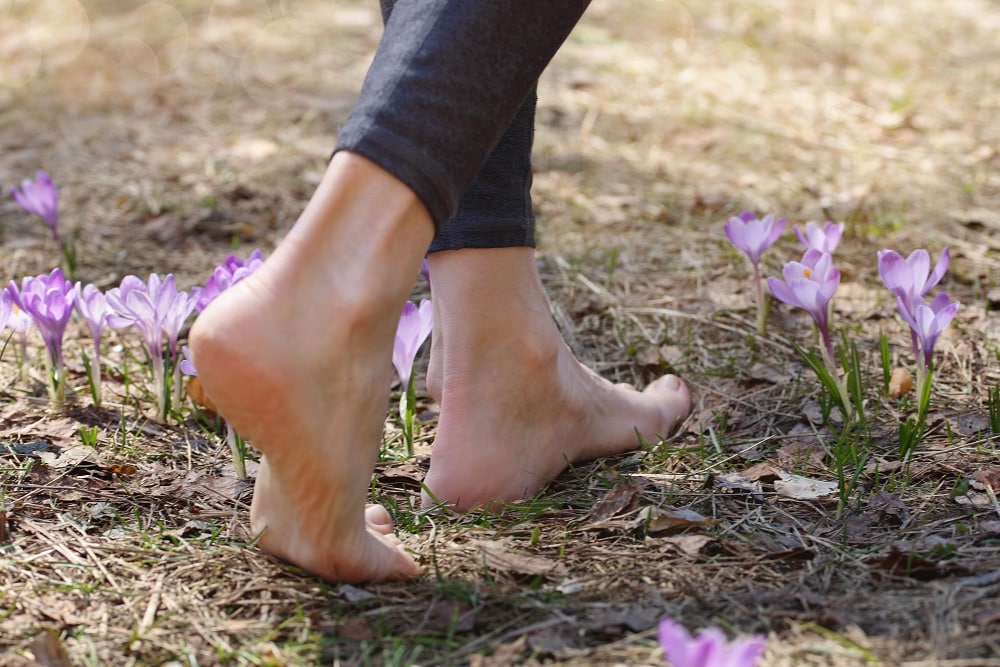
[adinserter block=”1″]
In today’s fast-paced world, stress and anxiety have become constant companions for many of us. It may feel impossible to get out from under our fears, worries, and other distressing thoughts. That’s why learning how to get grounded is so important.
Keep reading to discover seven quick and easy grounding techniques to reduce anxiety and help you enjoy a more peaceful, joyful life.
How to get grounded: 7 techniques to ease anxiety
Focus on your breath.
One of the most straightforward ways to get grounded is tapping into the power of your breath.
Focusing on your breath, by gently inhaling and exhaling through the nose, activates your body’s natural relaxation response. This simple practice has been scientifically proven to help reduce stress and create a sense of calm.
Turn your attention to your nostrils with curiosity. Do you notice a cool sensation as you inhale, a warm sensation as you exhale? Take long, deep, slow breaths, mentally noting “in” and “out” with each breath cycle.
You can also try a full-body breathing technique. Imagine that your whole body is breathing in, envisioning the air entering through your feet, expanding into your entire body, then exiting back down through your feet. This helps ground you in the here and now.
Feel your feet on the ground.
Reconnecting with your feet can bring you a profound sense of safety and stability. Try this simple exercise:
- Sit or stand with both feet flat on the ground, uncrossed.
- Focus on the sensation of your heels and soles touching the ground. Feel the support beneath you.
- Press one foot, then the other, firmly into the ground, engaging your thighs. Then, press both feet down simultaneously.
- Observe how these movements affect your spine and overall posture.
- Notice the feeling of both feet solidly connected to the earth.
- Continue until you feel a sense of grounding in your lower legs.
This is an easy practice that can help you get out of your head and back into the present moment, creating feelings of calm.
Practice earthing.
Earthing, also known as grounding, is the process of touching your bare skin to the earth. Studies have shown it has multiple significant effects on your health, including:
- Reducing inflammation
- Alleviating pain and stress
- Increasing blood flow
- Improving sleep and energy levels
- Supporting greater overall well-being
Earthing works by connecting your body to the earth, which has its own natural electric charge. This connection allows the earth to share its electrons with your body, helping to balance your body’s electrical energy.
It’s similar to how you would ground an electrical outlet to prevent electrical overload. This balancing act helps calm your body and mind, much like hitting the reset button on stress.
The best places to practice earthing are outdoor surfaces like:
- Soil
- Grass
- Sand
- Water, including streams, rivers, lakes, and the ocean
- Concrete
Try the 5-4-3-2-1 technique.
The 5-4-3-2-1 technique is a practical exercise aimed at calming the nervous system by using your senses.
It shifts your focus from anxiety triggers to a curious exploration of your current sensory experiences, altering the brain’s stress response and anchoring you in the present moment.
It involves the following steps:
- Acknowledge five things you see. Pause and notice five items in your immediate environment.
- Acknowledge four things you can touch. Identify and feel four objects around you, such as your clothes, a chair, a clock, or the floor.
- Acknowledge three things you hear. Tune into and recognize three sounds nearby, such as traffic, birds chirping, or a clock ticking.
- Acknowledge two things you can smell. Detect and acknowledge two scents–pleasant or unpleasant–like food, flowers, or any odor in your vicinity.
- Acknowledge one thing you can taste. Focus on one taste, perhaps from a recent meal, a mint, or just the taste of your saliva.
By engaging all five senses, the 5-4-3-2-1 technique redirects anxious thoughts back to the present, helping you feel grounded and calm.
Get moving.
Exercise is a scientifically proven method for reducing anxiety. When we engage in physical activity, our body releases endorphins–natural mood-boosting chemicals that alleviate stress.
Get out of your head and back into your body by doing some simple exercises, such as:
- Jumping jacks
- Jumping rope
- Jogging in place or around the block
- Stretching muscle groups one at a time
While doing these exercises, pay attention to your bodily sensations. Notice the feeling of your feet and/or hands as they touch the floor or move through the air.
This mindfulness element not only enhances the stress-relieving benefits of exercise but also keeps you anchored in the present moment, reducing anxiety and other distressing feelings.
Drink water.
Water is essential for life. It hydrates our cells and acts as an electrical conductor in our bodies, keeping our minds sharp and our systems functioning smoothly.
It also regulates body temperature, circulates oxygen and nutrients, and revitalizes our tissues. Plus, proper hydration is crucial for regulating stress hormones and supporting overall nervous system function.
Drinking water can be a grounding technique, in itself. Notice the cool sensation of the water as it flows down your throat and into your stomach. This can bring you back into your body, easing tension.
Pick up and hold onto something.
Holding and examining an object can be a powerful grounding technique.
Take a moment to pick up something nearby and notice its characteristics. Is it soft or hard? Light or heavy? Warm or cool?
Pay close attention to its texture and color. Challenge yourself to identify specific shades rather than general colors like red or green. This mindful practice of observing intricate details can help anchor you in the present moment, easing stress and anxiety.
These grounding activities are simple yet powerful ways to reduce stress and anxiety. Experiment with them to discover which ones work best for you. And practice regularly to cultivate a more peaceful, centered experience–no matter what life throws your way.
Worried About the Consequences of Osteoporosis and Bone Loss … Fractures, Weakness and Reduced Independence?
Click here to join Margie Bissinger, MS, PT, CHC, with 50+ expert talks to help you improve and protect your bone health throughout your life.
References:
Grounding – The universal anti-inflammatory remedy – PMC
Earthing: Health Implications of Reconnecting the Human Body to the Earth’s Surface Electrons – PMC.
What Surfaces Can I Be Grounded On? | BeGrounded
Regular exercise is associated with emotional resilience to acute stress in healthy adults
Effects of Exercise and Physical Activity on Anxiety – PMC
Water, Hydration and Health – PMC
Related
[adinserter block=”1″]
Credit : Source Post






